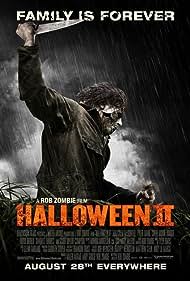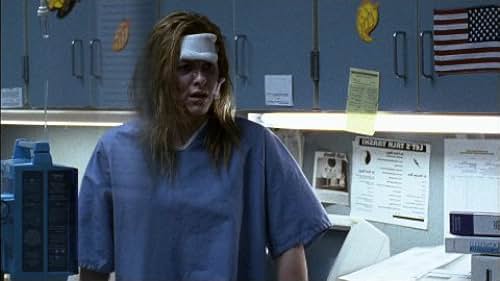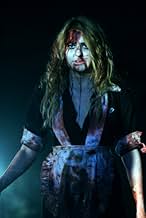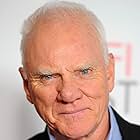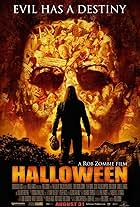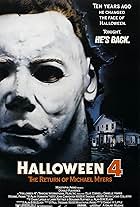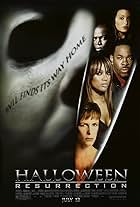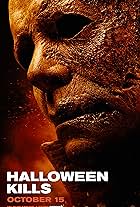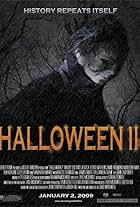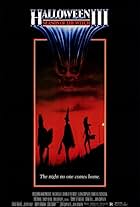Laurie Strode struggles to come to terms with her brother Michael's deadly return to Haddonfield, Illinois; meanwhile, Michael prepares for another reunion with his sister.Laurie Strode struggles to come to terms with her brother Michael's deadly return to Haddonfield, Illinois; meanwhile, Michael prepares for another reunion with his sister.Laurie Strode struggles to come to terms with her brother Michael's deadly return to Haddonfield, Illinois; meanwhile, Michael prepares for another reunion with his sister.
- Awards
- 1 win & 1 nomination
Chase Wright Vanek
- Young Michael
- (as Chase Vanek)
- Director
- Writer
- All cast & crew
- Production, box office & more at IMDbPro
Storyline
Did you know
- TriviaWhen Rob Zombie had to have a few days worth of footage shipped off for developing at the start of production, the film canisters were accidentally x-rayed by airport security, ruining the film reels and forcing several days worth of re-shoots.
- Goofs(at around 42 mins) During Loomis's interview in front of the dilapidated Myer's house it is obviously not the same house used in the previous film.
- Quotes
[from alternate ending]
Michael Myers: [before stabbing Loomis] Die!
- Crazy creditsStills of crime scene photographs of Michael's murders are shown over the credits.
- Alternate versionsThe Director's Cut runs 14 minutes longer (119 minutes). Among the changes:
- The opening scene with Laurie walking and Loomis being placed into the ambulance is longer.
- The hospital dream scene has an extra sequence of Laurie attempting to cross over a pile of bodies.
- An on screen title that said "One Year Later" in the Theatrical Cut now says "Two Years Later."
- During the breakfast scene, Laurie and Annie now argue about going to the psychiatrist.
- More dialogue with Laurie and the psychiatrist. Laurie looks at a framed inkblot on a wall and says that it looks like a white horse.
- Loomis' press conference is expanded. Loomis discusses Michael's Oedipal complex, as well as the idea that Michael perhaps saw Loomis as a father figure.
- Added sequence where Laurie runs a bath and begins to freak out.
- Laurie stopping to play with a pig on her way to work is removed. She instead goes to the psychiatrist and tells her about playing with the pig (we see a few seconds of it, now in flashback), and how it triggered a nervous breakdown of sorts. When the shrink denies her more pills, Laurie freaks out and swears.
- The scene where Annie finds Laurie drinking a beer in her room has been expanded: They have another fight.
- A non-masked Michael (along with Young Michael and his mother) angrily looks at a billboard that advertises Loomis' book.
- When Laurie and Maya come home from the party, there is a short added sequence of them making tea in the kitchen prior to going upstairs. There's also an added shot of Michael apparently walking out of the house.
- Brackett's reaction to finding Annie's body is longer, containing video flashbacks of real-life actress Danielle Harris as a child.
- The ending is significantly different: After Loomis enters the cabin, Michael throws him through a wall, and the two of them wind up outside. Michael then removes his mask, yells "DIE!", and stabs Loomis. The cops then open fire and kill Michael. Laurie then comes out, takes Michael's knife, and approaches Loomis with it, implying that she may stab him. The cops then open fire on her and seemingly kill her. We then fade to the same hospital footage seen at the end of the theatrical cut as a cover of "Love Hurts" plays on the soundtrack.
- SoundtracksEine Kleine Nachtmusic 2nd Mvt.
Written by Wolfgang Amadeus Mozart (as W.A. Mozart)
Performed by Rundfunkblasorchester Leipzig (as Leipzig Radio Concert Orchestra)
Courtesy of DeWolfe Music
Featured review
In my review of Quentin Tarantino's "Inglourious Basterds," I wrote that those put off by "Death Proof" would also likely be put off by his latest. Go figure that one week later, I am applying the same notion to Rob Zombie's sequel to his 2007 remake of "Halloween." One of the most heatedly derided remakes to date, I found Zombie's take impassioned and sincere while transcending John Carpenter's minimal, workmanlike low-budget-horror-flick terrain. While not a perfect film, "Halloween" epitomized (to me, anyway) the creative potential of the remake when placed in the right hands.
"Halloween II" finds Zombie returning to the Michael Myers maelstrom while tightening already-established character arcs, employing a harshly gritty style (courtesy of DP Brandon Trost), and topping it all off with a heapin' helpin' of carnage. Whereas "Halloween" focused on the inception and evolution of Michael Myers (Tyler Mane) from a murderous youth to the hulking masked madman we all know and love, Zombie's thematic focus this time out is "family" (and its many incarnations), using the traumatized character of Laurie Strode (Scout Taylor-Compton) as its axis.
Picking up one year after the fateful night her brother decided to come home, Laurie has become a punked-out version of her former virginal suburbanite self, and now resides with Sheriff Lee (Brad Dourif, sporting a Ted Nugent hairdo) and Annie Brackett (Danielle Harris). Meanwhile, the Eve of All Hallows is looming over Haddonfield like a shadowy blanket, with a rejuvenated, hooded-angel-of-death Michael Myers making a pilgrimage back home, guided by the specters of his younger self (Chase Wright Vanek) and his mother, Deborah (Sheri Moon Zombie). In the meantime, Dr. Sam Loomis (Malcolm McDowell) has become a pop-psychology celebrity, authoring yet another book on his last run-in with the notorious Myers.
With "Halloween II," Zombie drops the slick, polished look of the initial film, replacing instead with dark, grainy stock punctuated by flashes of neon and the soft focus of black & white. In many ways, the director has created a film that, like his characters, is schizophrenic in its style, cleverly threading complex dream sequences into reality, and cutting away from scenes with little warning. While the employment of dream sequences in most films is a cheap tactic for a "GOTCHA!" moment, Zombie keeps his motives ambiguous: do the dreams represent a psychic link between Laurie and Michael? the erosion of Laurie's sanity? Michael's distorted concept of pilgrimage? Either (and every) way, they give the proceedings a richly layered psychological weight that, in addition to their shock value, make us feel that the characters each have something at stake. The events leading up to the brilliantly-staged climax are both unpredictable and surprisingly affecting.
Unlike the "Saw" sequels (which have become the bane of the discriminating horror fan's existence), bathed in a hypocritical morality amid all the twisted flesh, spilled blood, and dungeon locations, Zombie is cognizant of death as something horrifying and destructive--the murders in "Halloween II" are played straight, executed with a fury that is disquieting; Myers has become a driven beast whose path of destruction possesses a joyless, workmanlike quality, removing any potential glamorization from the act. Every flesh-tearing slash, every helpless scream, cuts to the bone.
Quite admirably, Zombie uses his second go-'round with Myers as a chance to tie up character arcs and plot threads that felt truncated in the over-ambitious "Halloween": Loomis, who seems detached from most of the main plot, is given a chance to redeem his greedy, bottom-feeder ways; Sheriff Brackett gets to exhibit a paternal side, but also an authoritarian mentality once the code of law is broken (he has several great, emotionally wrenching scenes near the end of the film); as Deborah, Sheri Moon Zombie's detached, trancelike performance is apt for the physical manifestation of the voice guiding a psychotic mind. Amid the carnage of his corpse-strewn landscape, Zombie's interest in character interaction and moral ambiguity gives "Halloween II" a depth that, for those with the stomach to take it, is downright refreshing.
"Halloween II" finds Zombie returning to the Michael Myers maelstrom while tightening already-established character arcs, employing a harshly gritty style (courtesy of DP Brandon Trost), and topping it all off with a heapin' helpin' of carnage. Whereas "Halloween" focused on the inception and evolution of Michael Myers (Tyler Mane) from a murderous youth to the hulking masked madman we all know and love, Zombie's thematic focus this time out is "family" (and its many incarnations), using the traumatized character of Laurie Strode (Scout Taylor-Compton) as its axis.
Picking up one year after the fateful night her brother decided to come home, Laurie has become a punked-out version of her former virginal suburbanite self, and now resides with Sheriff Lee (Brad Dourif, sporting a Ted Nugent hairdo) and Annie Brackett (Danielle Harris). Meanwhile, the Eve of All Hallows is looming over Haddonfield like a shadowy blanket, with a rejuvenated, hooded-angel-of-death Michael Myers making a pilgrimage back home, guided by the specters of his younger self (Chase Wright Vanek) and his mother, Deborah (Sheri Moon Zombie). In the meantime, Dr. Sam Loomis (Malcolm McDowell) has become a pop-psychology celebrity, authoring yet another book on his last run-in with the notorious Myers.
With "Halloween II," Zombie drops the slick, polished look of the initial film, replacing instead with dark, grainy stock punctuated by flashes of neon and the soft focus of black & white. In many ways, the director has created a film that, like his characters, is schizophrenic in its style, cleverly threading complex dream sequences into reality, and cutting away from scenes with little warning. While the employment of dream sequences in most films is a cheap tactic for a "GOTCHA!" moment, Zombie keeps his motives ambiguous: do the dreams represent a psychic link between Laurie and Michael? the erosion of Laurie's sanity? Michael's distorted concept of pilgrimage? Either (and every) way, they give the proceedings a richly layered psychological weight that, in addition to their shock value, make us feel that the characters each have something at stake. The events leading up to the brilliantly-staged climax are both unpredictable and surprisingly affecting.
Unlike the "Saw" sequels (which have become the bane of the discriminating horror fan's existence), bathed in a hypocritical morality amid all the twisted flesh, spilled blood, and dungeon locations, Zombie is cognizant of death as something horrifying and destructive--the murders in "Halloween II" are played straight, executed with a fury that is disquieting; Myers has become a driven beast whose path of destruction possesses a joyless, workmanlike quality, removing any potential glamorization from the act. Every flesh-tearing slash, every helpless scream, cuts to the bone.
Quite admirably, Zombie uses his second go-'round with Myers as a chance to tie up character arcs and plot threads that felt truncated in the over-ambitious "Halloween": Loomis, who seems detached from most of the main plot, is given a chance to redeem his greedy, bottom-feeder ways; Sheriff Brackett gets to exhibit a paternal side, but also an authoritarian mentality once the code of law is broken (he has several great, emotionally wrenching scenes near the end of the film); as Deborah, Sheri Moon Zombie's detached, trancelike performance is apt for the physical manifestation of the voice guiding a psychotic mind. Amid the carnage of his corpse-strewn landscape, Zombie's interest in character interaction and moral ambiguity gives "Halloween II" a depth that, for those with the stomach to take it, is downright refreshing.
- Jonny_Numb
- Aug 28, 2009
- Permalink
Details
- Release date
- Country of origin
- Official sites
- Language
- Also known as
- Halloween 2
- Filming locations
- Production companies
- See more company credits at IMDbPro
Box office
- Budget
- $15,000,000 (estimated)
- Gross US & Canada
- $33,392,973
- Opening weekend US & Canada
- $16,349,565
- Aug 30, 2009
- Gross worldwide
- $39,421,467
- Runtime1 hour 45 minutes
- Color
- Sound mix
- Aspect ratio
- 1.85 : 1
Contribute to this page
Suggest an edit or add missing content

